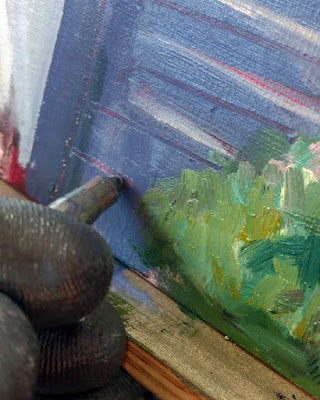It may seem like a fine brush is better, but that’s not always true in wet-on-wet painting.
|
Sea Fog on Main Street, by Carol L. Douglas. When painting plein air, you don’t have time to wait for the painting to dry to draw lines.
|
I’m working on a commission that has a lot of architectural detail. I don’t want the end result to be fussy. I’m not a clean renderer like Frank Costantino. He can drop a fine line with a rigger and it falls into the painting, cool and elegant.
Watercolor loves fine lines. Alla prima oil painting doesn’t. It tends to be looser and rougher. A fine line added with a rigger can lie on the surface looking silly, or it can melt into the bottom layers and look like mush.
 |
| Working backwards allows you to make clean edges without being overly fussy. |
My solution is to paint edges and lines in reverse. I lay down the line and then back the color up to meet it.
Lines should be happening on an already-wet surface, because they aren’t important in the big-shape phase. That means you need a technique for removing excess paint before you draw. For large erasures, I take off excess paint with a palette knife. For lines, I use a wipe-out tool. I had a very old one made by Loew-Cornell that I lost this summer. I replaced it with a terrible one I picked up on the road. But Bobbi Heath assures me this is the best one currently available.
 |
| Start by getting rid of excess paint. |
Getting rid of that schmearof excess paint is an important first step. You can’t draw into soup.
Lay the line in before the surrounding background. With architecture, this often means a line of light-colored paint before its dark surround. Don’t worry that you’ve broken the dark-to-light rule. Lines are usually added toward the middle or end of a painting, so you should be past that point anyway.
In oils, the side of a flat brush always works better than a tiny round for straight lines. Flats are more stable and tends to track in the right direction. Go ahead and use a ruler if you want.
 |
| The line going on with a bright. |
This line should be made of fairly thin paint, with just enough medium to carry it smoothly. Too much oil and it will blend into its surround.
 |
| It’s easier to paint a line with a flat on its side than with a small round. |
Next paint the surrounding area, pushing up against the line with the background color. Use enough paint and be bold. It’s best to do this edging in a single stroke, but that takes practice. However, as a general rule, the more you touch the surface, the muddier the edges will get.
 |
| Then push the background color right up against the line. |
In my examples, I use two different brushes. The fine flat, made by Rosemary & Co., was a gift this summer. It is very precise, but as with all synthetic fibers, it doesn’t carry much paint. The bright is old and clunkier, but it carries enough paint for a good, finished line. It may seem like finer is better, but that’s actually not true. What’s most important is getting enough paint on the canvas, evenly, so that your line doesn’t look anemic. I find that with alla prima painting, hog bristles are almost always better.
 |
| After two flags, a chair, and a lot of white trim, I was so cramped up by precision that I had to do this fast surf exercise to wash out my mind (and loosen up my hand). |
I enjoyed painting with the Rosemary & Co. flat, but it was no good for surface work. Eventually, I realized I didn’t like my painting at all. I set it aside and did a fast exercise with big brushes that got rid of the stiffness that had crept into my painting from using the wrong brush.
